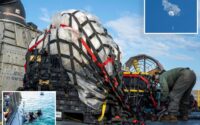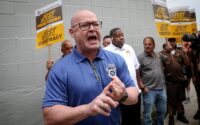How smugglers flood the US with Chinese fakes
It’s easy to look down on the counterfeit handbags you see strewn across bridge tables on Manhattan’s Canal Street, where knocked-off designer clutches sell at a fraction of the cost that retailers charge for the real thing.
But there is no doubting the industriousness that gets the goods from a factory in China to a busy thoroughfare in Manhattan to the hands of status-conscious bargain hunters.
And it’s not just the bargain-basement wannabes. In 2008, it was alleged that Celine Dion was seen shopping for knockoffs in Shanghai. (The proprietor claimed she was there to have her fortune told.)
Some of the Louis Vuitton counterfeits even come in copies of the tell-tale orange boxes that contain the real things.
In fact, according to Dan Harris, a lawyer who helps companies to navigate global intellectual property issues and heads up China Law Blog, the process of making counterfeits is not so different from that of legitimate manufacturing. “Sometimes the bags are made [off hours] in factories that produce legitimate handbags by day,” Harris told The Post.
“Some of them have quality control, good materials, professional equipment. The big difference, though, is that, with the knock-off, it may fall apart in a week and all your stuff winds up on the ground.”


Here, then, is the trek from conception to production to transport to sale of the sketchy goods that bargain-basement consumers find irresistible.
CHASING HEAT: HOW FAKERS FOLLOW TRENDS
Some luxury bags are perennials – for the legitimate manufacturers and the counterfeiters – such as the classic Louis Vuitton and the Prada tote.
Then there are the ones that seem to blow up overnight, when a Kardashian parades it past a red carpet. It shows up on Page Six, gets touted by influencers and suddenly everyone knows it’s a hot look.
Like when Kim Kardashian bought multi-colored Vuitton bags for her daughters and her nieces in the extended Kardashian family.
“There are people in China scanning the Internet at all times,” Harris said. “Nike knows what Adidas is doing and these counterfeiters know what all of the in-demand brands are doing.”

MAKING THE FAKE: HOW BAGS GET COPIED PRECISELY
Once a particular model is seized upon, things can go in a variety of ways. If the illicit manufacturer had already made the bag, then production can start immediately. If not, a pattern maker is employed to create the pattern.
That could be done through a photo or by buying the actual bag and deconstructing it.
As for the cost, said Harris, “Whatever minimum wage is, that is what she will be paid.”
In Guangzhou, which, according to a former NYPD undercover detective who now goes by Big Frankie, is a top place for making knock-offs of everything from handbags to cigarettes to auto parts, minimum wage runs in the range of $2.50 an hour.


To put in an order for bogus bags, though, one needs to get beyond the pattern maker. “You’d likely meet with a go-between for the factory owner,” Big Frankie, who is writing his memoir, told The Post. “You would need substantial status to meet with the actual factory owner.”
Bags might be produced at night, when the legit runs are finished. “Or else they could be made in a factory that does nothing but produce counterfeits,” Bill Ryan, a former NYPD detective who now heads up Ryan Investigative Group, which goes after counterfeiters for corporations, told The Post. “You want to order at least 10,000 bags at a time. You need to make enough for it to be as cheap as possible.”
GETTING THE GOODS OUT: FAKE PAPERS AND BRIBES
Once the bags are manufactured, they get put into shipping containers for the overseas journey from China to the US. “The purses are made flat as pancakes,” said Ryan, who is also working on a memoir. “And you don’t put them into a box labeled ‘counterfeit bags.’”
Instead the flattened handbags wind up a box identified as containing a legitimate good. “It may be marked ‘umbrellas,’” said Big Frankie. “Then they put the bags in the backs of 20’ by 40’ metal containers and load the rest with umbrellas. The expediter, who probably does legitimate and illegitimate stuff, prepares paperwork to make the container look good.”
That container gets loaded onto a truck with other containers before it is driven to the outbound dock in China.

By that point, according to Big Frankie, payouts have been made along the way: “The pattern maker got taken care of [maybe receiving extra, since the work is illegitimate], the factory crew was paid, a middleman who hooked you up got his cut, the expediter was paid and you may have to pay somebody at the dock.”
Once there, according to Big Frankie, “They work with a shipping company that is friendly to what they are doing. It gets a container number, goes on a ship and would likely end up in Newark, NJ, or Long Beach, California. The recipient in America has to keep his fingers crossed that it gets through.”

Reducing the opportunity for bad luck, explained Ryan, “the container gets put on the back of the ship. That lessens the likelihood of it being checked out.”
What happens to the umbrellas? Replied Big Frankie, “The guy in America gets the umbrellas along with the counterfeit bags. He figures out how to sell them.”
At this point, according to Harris, the bags would have cost around $20 each to manufacture. He estimates that the person who ordered them will pay around $25 per bag, including shipping.

“Duty can be minimized by shipping the container from China to a place like Vietnam or Cambodia, en route to the US, and claiming that the contents were made outside of China,” said Harris.
“This is called illegal trans shipping. We brought a case to the US government on behalf of our client where a company was fined $62.5 million for engaging in this activity.”
Not surprisingly, the Chinese manufacturers make their money whether the goods get grabbed or not. “You pay up front,” said Ryan. “In case the shipment is seized, the Chinese guy has his money. He’s not going to lose out.”
GETTING THE GOODS IN: ‘WHO’S WORRIED ABOUT FAKES?’
Once the products land Stateside, the likelihood of them being confiscated are fairly remote. “Homeland Security searches 10- or 15-percent of what comes into this country,” said Ryan. “Is anybody really worrying about fake handbags? They’re worrying about weapons and drugs.”
A legitimate pick-up company retrieves the shipment at the American port and takes the goods to its warehouse.


The American contact then gets the goods and prepares them for distribution. Often they use self-storage facilities, which have proliferated across the country.
“They can be transported to any number of self-storage facilities,” said Ryan. “There will be signs there that read, ‘No counterfeit goods allowed.’ But [the storage guys] don’t give a damn. They want to sell storage. During my NYPD days, I used their lockers to store my counterfeit evidence.”
STORAGE WARS: HOW BOSSES PREPARE TO BE RAIDED
A boss who manages the street dealers will pay the wholesaler $35 to $40 dollars per bag, according to Harris.
Then the boss too will stash them, spreading the purchase across sites in the city. That New York City is loaded with small apartments and blessed with many storage spaces is a plus for the counterfeit peddlers.
“If they have 10,000 handbags,” said Big Frankie, “they may get spread across 10 different storage spaces. That way, if one gets raided, they don’t lose all of their bags.”

In some instances, a visit to the storage space provides an opportunity for one-stop shopping. “I did a big raid in the Bronx,” Ryan recounted. “Counterfeiters in the warehouse were selling boots, CDs, jeans. And the people managing these places, they know what time it is. They don’t care if you are in there doing illegal stuff.”
The spread-out is also convenient from a sales standpoint. Sellers of illicit goods, scattered around the city, can go to nearby storage centers to score inventory.
“It’s very easy,” said Ryan. “You go to the guy’s locker, with one of the facility’s carts, buy what you want and take it out on the loading dock. But you need to purchase at least $500 worth of stuff. Buy just one or two bags and the sellers will figure you are a cop.”


TO THE STREETS…
The boss will front them to the street dealers and expect to receive $60 per bag after they are sold.
Raids do happen. Sometimes, even on the streets, as was the case last November: The NYPD seized more than $10 million in “high end” knock-offs.
But raids do not put off people patronizing the retailers, who sell knock-off bags for $70 to $140, depending on the negotiating skills of customers.


As one eagle-eyed Canal Street shopper casually told The Post earlier this month, “The gold in the logo is a bit off and inside you can see the logos are backward.”
Sometimes, though, the shoddiness of a knock-off goes beyond the cosmetic. “Buy a counterfeit,” said Harris, “and there is nobody to hear your complaint when it falls apart.”






